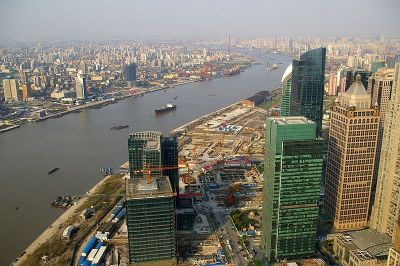Trouble in River City
 Ever since H7N9 was thrown at the world by the Chinese the night of March 31st, everyone familiar with events in China has wondered if there was truly any correlation between the sudden/whiplash emergence of this new flu substrain and the equally sudden and gut-wrenching sight of thousands of dead pigs floating down the Huangpu River.
Ever since H7N9 was thrown at the world by the Chinese the night of March 31st, everyone familiar with events in China has wondered if there was truly any correlation between the sudden/whiplash emergence of this new flu substrain and the equally sudden and gut-wrenching sight of thousands of dead pigs floating down the Huangpu River.
The Huangpu is the principal water supply for Shanaghai, as well as other areas. From Wikipedia:
Shanghai gets most of its drinking water from the Huangpu, and dumps most of its sewage into it (4 mln tonnes in 1990., only 4% of it treated in any way). As a result of pollution, the tap water must be heavily chlorinated.[2]
In February and March 2013, thousands of pig carcasses were found floating in the Huangpu River in Shanghai. Some of the pigs carried ear tags saying they were from Jiaxing, so that city in Zhejiang may be the source; however local farmers deny that.
Let us look at Apple Maps. Apple Maps has the Huangpu running through Cleveland. No! Dang that Apple Maps!
Let's look at a different source. The Huangpu is, by all accounts, a beautiful river. Regrettably, these days it has looked like this:
 The latest count has more than 20,000 dead pigs having been recovered from the Huangpu, many/most of them in and immediately around Shanghai.
The latest count has more than 20,000 dead pigs having been recovered from the Huangpu, many/most of them in and immediately around Shanghai.
It would be natural to speculate whether or not the pigs are the vector causing H7N9 to appear in humans. However, testing of roughly 34 carcasses has not revealed the presence of the virus.
Admittedly, a sample of 34 pig carcasses in a twenty-thousand carcass deluge is a small sample. However, it does appear that the two events are just coincidental.
From the British newspaper The Guardian:
This area of Zhejiang province, 60 miles from Shanghai, has become the subject of public and media scrutiny after more than 16,000 dead pigs were found in tributaries of the city's river, the Huangpu, a source of tapwater. As clean-up efforts wind down, mystery surrounds the cause of the pigs' demise and their appearance in the river.
As public concerns about water safety grow, what has emerged is a picture of a rural region marred by catastrophic environmental damage, inherent malpractice and a black market meat trade.
The first pigs were spotted on 7 March and were soon traced to Jiaxing through tags in their ears. Early tests show they carry porcine circovirus, a common disease among hogs not known to be infectious to humans. Shanghai's municipal water department maintains that the water meets the national standard, but hasn't said much more.
Again, the two events appear unrelated. However, the dates intersect with such similarity, and the provinces and cities are the same ones that are impacted by H7N9, that it is easily understood why the linkage would be there.
However, had the pigs been the vector, I have to think the Chinese Army would have exterminated and either buried or burned the pigs, and loudly proclaimed that the source of the infection was found and eradicated. they also would have found the presence of H7N9 in pigs upstream of Shanghai. In the Internet age,
The simple fact is that these events, however crazily coincidental, appear to be unrelated. However, I offer the possibly opposite view, by none other than Laurie Garrett. Laurie is well-known to infectious disease experts and readers of blogs. Her works have garnered her much distinction, and she is a Fellow at the Council on Foreign Relations (CFR). She was a consultant for the film COntagion and is highly-respected.
In Laurie's view, there is a possible connection between H7N9, the pig die-off (and she makes a very persuasive case for this), and the mass die-off of swans and ducks near Qinghai Lake. Qinghai is well-known to veteran flu followers: It is the origin of Clade 2.3 of H5N1 bird flu. It would not be a stretch to imagine Qinghai spawning yet another mutated bird flu. Laurie's excellent article can be found here.
In this fog of flu reporting, we will hear many things. Like most pandemics, and if H7N9 indeed becomes pandemic, the view will be in hindsight, via historians and researchers. But Laurie brings an interesting perspective to this puzzle.
Indeed, perhaps there are no coincidences here. Let's just hope that's all they are.

Reader Comments